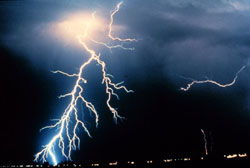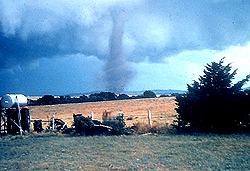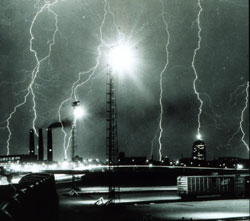|
The sight
of lightning is fascinating, the destruction it can cause can be
devastating. Earle Williams has been studying the effects of lightning
for 25 years and talked to FirstScience about his work and his experiences.
FirstScience: How long have you been studying the effects of
lightning?
Earle Williams: I have been involved with research on thunderstorms
and lightning for about 25 years, with field projects in Massachusetts,
Alabama, North Carolina Colorado, New Mexico, Florida, Australia,
and Brazil.
FS: What
is the worst storm that you have experienced?
EW: I have experienced
many active storms and it is difficult to identify a grand winner.
I recall a storm that came off an escarpment in the Top End of Australia,
flashed continuously, and produced a nearby ground flash that vaporized
a TV antenna perhaps 10 meters away. That got our attention. In
tropical Brazil last year, an unusual storm with rotating updraft
was continuously illuminated by intracloud lightning. The radar
cloud top was an exceptional 19km high. This was probably the most
active storm I have ever seen in the tropics.
What may seem
surprising is that I have never witnessed firsthand a tornadic storm,
though have studied the data for a large number of them.

NOAA
The
power of lightning can range from ten to several hundred megavolts
|
The great majority
of tornadic thunderstorms in the world occur in the Great Plains
of North America, but I have not been an active 'chaser' in that
region.
FS: What causes
lightning?
EW: Lightning is a giant electrical spark and is caused by the
separation of electrical charge in a thunderstorm. The mechanism
of charge separation is still poorly understood but there now seems
little doubt that ice particle collisions are involved and the conditions
favorable to ice particle collisions are strong updrafts which invigorate
a thunderstorm's ice factory. Charge separation by particle collisions
occurs until the voltage difference in the cloud reaches 10 to 100
megavolts and the local electric field reaches several hundred kilovolts
per meter. The latter field is the approximate dielectric strength
of the thundercloud medium and its attainment is required to initiate
ionization, the initial stage of the large spark that is lightning.
FS: How many different types of lightening are there and which type
is the most powerful?

NOAA
Cloud-to-ground
lightning is the most dangerous for humans
|
EW: One can make a broad separation between lightning that contacts
earth (cloud-to-ground lightning) and lightning that does not (intracloud
lightning). Generally, the lightning type of concern for human safety,
the initiation of forest fires and the destruction of electronic
equipment is the cloud-to-ground flash, and as a consequence, this
type of lightning is targeted by operational networks for lightning
detection. Within these two broad categories, there are other subcategories.
Cloud-to-ground lightning can transfer either negative or positive
charge to earth. The great majority of ground flashes are negative,
but the most powerful and most dangerous are the positive ground
flashes that can also produce sprites in the mesosphere. Positive
flashes occur in the decaying phases of large thunderstorms and
in the very active stages of severe storms. Intracloud lightning
is far more prevalent than cloud-to-ground lightning, and the mean
peak currents in intracloud lightning tend to be smaller. Intracloud
flashes that leave cloud base and approach ground, but do not reach
ground, are called air discharges. Intracloud lightning that leaves
cloud top and heads upwards are sometimes referred to as cloud-to-ionosphere
flashes. Intracloud flashes that bridge two thunderstorms are called
intercloud flashes. In the active stages of severe storms, intracloud
flashes can outnumber ground flashes by 10-100 to one.
FS: What
research are you currently carrying out?
EW: Two areas
are receiving most of my attention at the moment: studies of the
Earth's Schumann resonances and lightning in severe Florida thunderstorms.

NOAA
Every
strong lightning flash in the world can be detected at the
station in Rhode island
|
The measurements
of Schumann resonances provides access to many things on a global
basis. These are electromagnetic standing waves trapped in the Earth-ionosphere
cavity and maintained by global lightning. We record these signals
in the remote woods of western Rhode Island. The fundamental resonant
frequency is 8 Hz. Every lightning radiates a small amount of energy
at 8 Hz and so contributes to the quasi-continuous background signal
of Schumann resonances. Every few minutes or so, a single extraordinarily
energetic lightning will single-handedly 'ring' the Earth-ionosphere
cavity and such events can be located from the Rhode Island station
on a global basis. The most energetic events of all are large ground
flashes with positive polarity and accompanying horizontally extensive
'spider' lightning. Many of these events also trigger sprites high
in the mesosphere (75 km altitude), a luminous phenomenon shaped
like jellyfish but as large as a thunderstorm itself. The global
mapping capability for large lightnings thereby provides indirectly
a global map for sprites. The electromagnetic signals can be used
to compute the dipole moment change of the lightning and from this
one can determine whether the field increase over the storm is large
enough to produce a sprite.
The analysis
of the electromagnetic signal for individual lightnings can also
be used to explore the properties of the ionosphere which is the
upper boundary of the Earth-ionosphere waveguide. Recent comparisons
of measurements between Hungary (by our collaborator Dr. Gabriella
Satori) have shown small but systematic increases in the Schumann
resonance frequencies at both stations which can be attributed to
the changes in ionization in the upper D region of the ionosphere
on the 11 year solar cycle. We are presently near the maximum of
this cycle, and so the resonant frequencies are also near their
peak values.

NOAA
Tornadic
storms may be predicted in future by the lightning patterns
in the preceding storm clouds
|
Studies on severe
weather in Florida are also underway with MIT Lincoln Laboratory
and NASA Marshall Space Flight Center. The main interest at present
is the behavior of total lightning flash rate that may signal the
occurrence of a tornado. We have found already that strong upsurges
in total flash rate, dominated by intracloud lightning, tend to
precede all forms of severe weather on the ground (hail, wind, tornadoes)
by 5-15 minutes. One challenge at present is to identify features
that may distinguish a tornado from another form of severe weather.
FS: How do you measure the volts in lightning?
EW: Measuring the voltage of lightning itself is probably a near
impossible task, because in general we are unable to predict where
a lightning will occur to make the appropriate measurement. One
can however estimate the voltage difference developed in a thundercloud
before it produces lightning by measuring the vertical variation
of electric field from the ground to the center of electric charge
in the storm with balloon-borne measuring equipment. The integral
of this vector electric field is the total voltage available to
drive the lightning. The values one obtains are in the range of
ten to several hundred megavolts.
FS: Can we make use of lightning in terms of power?
EW: If lightning occurred in one place in a predictable manner
day in and day out, the harnessing of its energy might be seriously
considered. Such is not the case. Lightning does strike twice in
the same place, but extremely infrequently. To harness the energy,
the lightning must strike an electrode connected to a very robust
bank of electrical capacitors. One captured strike would deliver
at most 10^8 joules. This would provide enough energy to power one
electric hairdryer for about ten hours. So clearly, a large number
of captured flashes would be needed to supply the energy needs of
just a single household.
FS: What is the ‚€˜global circuit‚€™ and what have you learnt from
this?

NOAA
Lightning
is more common in warmer conditions but its sensitivity to
global warming is still unknown
|
EW: The global circuit is the framework set up by the Earth, the
ionosphere and all the electrified weather in the insulating air
layer in between. Electrified storms pump current from the Earth
to the upper atmosphere and thereby maintain a 250 kV voltage difference
between Earth and ionosphere - a giant spherical capacitor. The
same pair of concentric conductors (Earth and ionosphere) make up
the electromagnetic waveguide that contains the Earth's Schumann
resonances which we discussed earlier. Both aspects of the global
circuit - the 'DC' version with the 250 kV ionospheric potential
and the 'AC' version with Schumann resonances, provide integrated
estimates of global weather measurable at single locations on the
Earth's surface. This situation provides a natural framework for
studying global change. For several years we have been intrigued
with the idea of monitoring temperature variations with the global
circuit, following well recognized local observations indicating
that, on average, warmer conditions favor more lightning. Within
the past decade, both the 'DC' and 'AC' global circuits have been
examined for sensitivity to temperature on a variety of time scales
- the diurnal, the intraseasonal (20-60 days), the semiannual, the
annual and the El Nino time scale - all with some indication of
a correlation with temperature and with a sensitivity of some tens
of percent per degree centigrade. The global circuit sensitivity
to global warming is still highly uncertain, the available record
lengths are short and the natural variability of the global circuit
is large. This work is now in progress along with notable gains
in our ability to measure the global circuit, a capability that
has greatly lagged our conceptual understanding.
FS: We need batteries and motors to produce electricity, how
is lightning produced in our atmosphere?

NOAA
Electrical
storms pump current from the Earth to the upper atmosphere
|
EW: The details of charge separation leading to lightning generation
are still poorly understood, particularly in comparison with conventional
batteries and motor-generators that routinely produce electricity.
The inhospitable environment of the thunderstorm has greatly slowed
progress toward this solution. We do know that mixed phase conditions,
in which water substance in all three of its phases (vapor, liquid,
and solid) is an essential aspect of vigorous charge separation.
Millimeter- to centimeter- sized graupel particles grow by accreting
supercooled droplets which subsequently freeze on the graupel surface
to add to its mass. The graupel particles develop appreciable fall
speeds relative to the surrounding air and collide with ice crystals
and smaller graupel particles. It is widely believed that microphysical
differences in these colliding particles lead to selective transfer
of negative charge to the larger particles and positive charge transfer
to the smaller particles. The subsequent differential motions under
gravity result in the large scale vertical dipole of a thundercloud
with positive charge uppermost and negative charge in the lower
portion of the mixed phase zone.
FS: How many people each year are struck by lightening?
EW: As I recall, approximately 300 people per year are struck by
lightning, or about one person per day worldwide. Recent surveys
indicate a considerable underreporting of such strikes. A surprisingly
large number of people live to tell about a lightning strike to
their person. Several medical doctors specialize in lightning injury.
|
